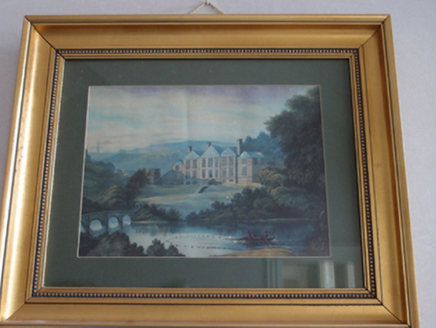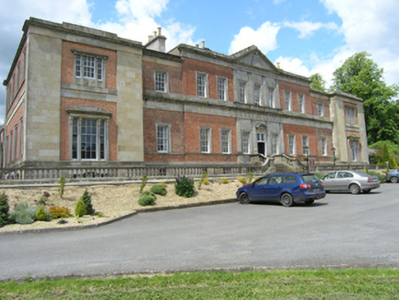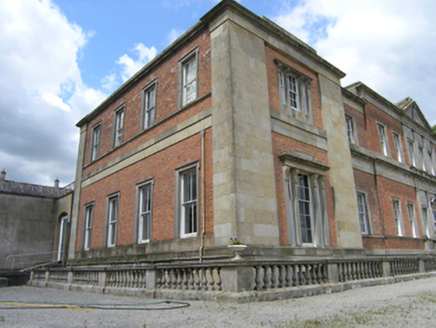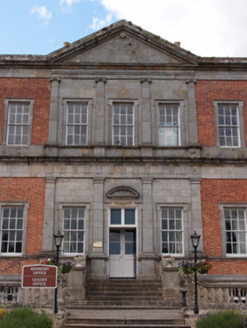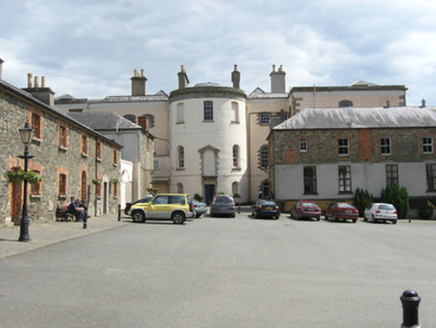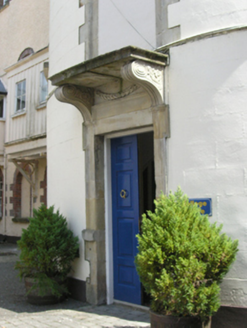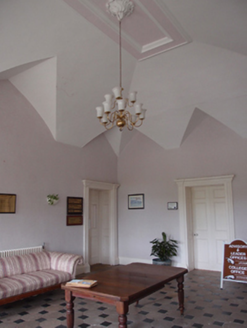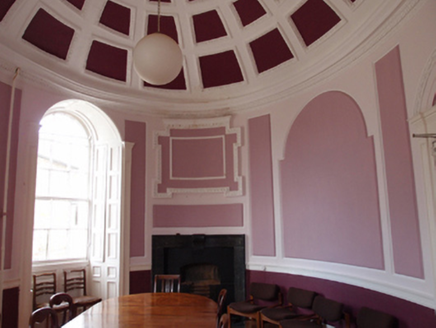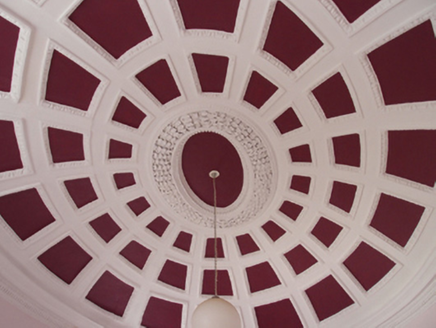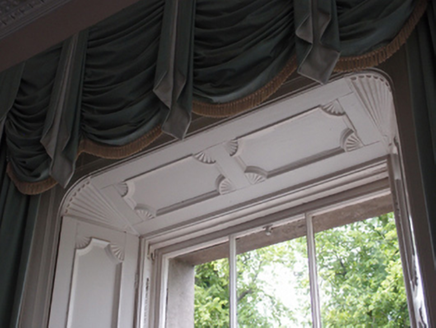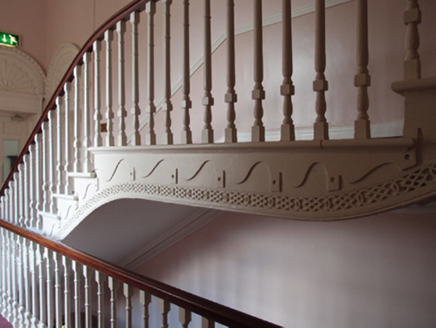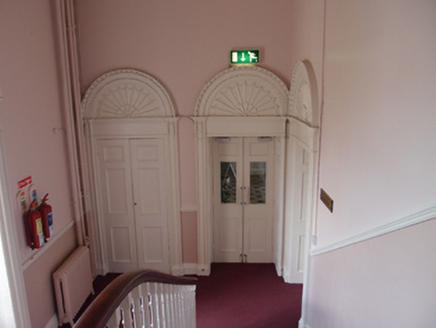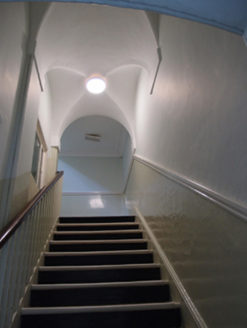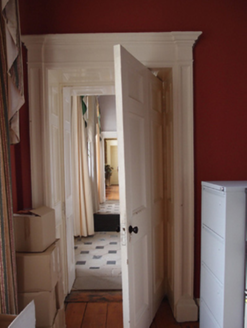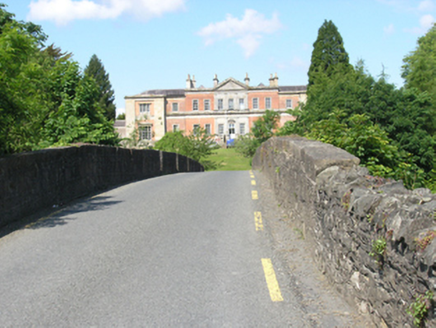Survey Data
Reg No
40401620
Rating
National
Categories of Special Interest
Architectural, Artistic, Historical, Social
Previous Name
Ballyhaise House
Original Use
Country house
In Use As
Faculty building
Date
1730 - 1740
Coordinates
245137, 311601
Date Recorded
11/06/2012
Date Updated
--/--/--
Description
Detached eleven-bay two-storey over basement former country house, built c.1735, possibly with core of c.1700, comprising seven-bay central block having pedimented centre bays with superimposed orders and a three-bay semi-circular bow to rear elevation. Lower outer bays added c.1820 with recessed intermediate bays and advanced end bays having tripartite windows, southern bay forming end of four-bay side elevation. Now in use as college. Hipped and slated roofs with lead ridges and rendered chimneystacks of simplified Vanbrughesque design, having clay chimneypots with lotus-flower decoration. Parapet to central block as stone entablature with central pediment retaining trace of tympanum sculpture, similar entablature over bow to rear, lower stone cornices to outer bays and south wing. Red brick walls with architectural detailing of ashlar sandstone to front of main block and to later end wings, ashlar stone to centre three bays. Centre bays articulated with pilasters in superimposed Doric and Ionic orders, upper Ionic order having pulvinated frieze and cornice extending across higher central block. Doric order having blank metope frieze, cornice carried across central block and intermediate bays with plain ashlar band above and plain frieze below. Plain raised ashlar bands flanking end bays over both storeys carried round to the side elevations. Ruled-and-lined rendered walls to basement below string course at window head level and ashlar outer bays. Side elevation to south with simplified banding courses at mid height and a continuous string course under the upper storey sills. Side elevation to north of rubble stone with brick surrounds to openings and large quoins to the north-west corner. The rear elevation of roughcast render, smooth ruled-and-lined render to bow. Shouldered architraves to ground and first floor windows with ashlar sill course at ground floor and six-over-six timber sash windows. Tripartite windows to outer bays with ashlar mullions and cornice hoods on scrolled brackets, six-over-nine timber sash windows to centre section at ground floor windows. Segmental-headed windows to basement with plain architraves and six-over-six timber sashes. Square-headed door opening to central bay with recent glazed double-leaf entrance doors in shouldered architrave surround topped by a segmental pediment with shell motif over carved floral garland. Rear elevation with round-headed windows to basement and ground floors, segmental-headed to first floor, both types having plain reveals to bow and brick surrounds elsewhere. Square-headed door opening to bow with shouldered architrave surmounted by corbelled canopy with carved sandstone swag motif, round-headed blind door opening to main ground level above with Gibbs surround and open-bed pediment on scroll brackets. Entrance hall with plastered brick-vaulted ceiling with deep severies and coffered centre. Black and white stone floor tiles and tall Kilkenny limestone open-bed pedimented chimneypiece. Four main reception rooms off hall, Bishop's Room having marble chimneypiece, running mould cornice and decorative centrepiece. Peacock Room having plastered brick-vaulted ceiling with elliptical-headed formerets, modillion cornice and heavy foliate centrepiece. Walls having hand-painted wallpaper with dado rail and deep skirting, panelled window joinery and panelled door with flanking pilaster architraves and plain entablature over-door and replacement marble fireplace. Oval Room in bow opens off hall to rear with compartmentalised oval ceiling having dentil cornice and foliate centrepiece, stucco panelled walls with dado rail and round-headed windows with panelled window joinery, curved Kilkenny limestone chimneypiece having central corbel with fish-scale design. Ballroom now in use as a lecture room with decorative modillion cornice and centrepiece with decorative feather motifs, dado rail and deep skirting boards, Carrara marble chimneypiece with fluted Corinthian columns supporting mantle having decorative Greek key and palmette motif to lintel. Panelled window shutters, soffits and window backs with fan detail to reveals, timber panelled doors with similar fan details to panels and overdoor with floral garlands. Stair hall off entrance hall to south with service stair beyond lobby room to the north. Dogleg stair from basement to first floor with sandstone steps from ground floor to basement. Turned balusters set on pears and blocks and scrolled tread ends with decorative fretwork detail. Door openings in stair hall have round-headed overdoors with decorative spider-web motif emulating fanlight and flanking pilaster architraves. Dining room in end bay now used as a boardroom with decorative cornice having palmette motifs, grey marble chimneypiece having flanking Ionic columns, timber panelled window and doors with fan details to panels and decorative floral garland to overdoor. Arched recess to west-end wall. Offices to basement all with brick vaulted ceilings, stone flags in parts with black and red quarry tiles to entrance hall, plain rendered window embrasures with simple historic timber shutters to some windows and some cast-iron fireplaces. Ground floor raised above surrounding area opening onto steps flanked by balustrade at raised level enclosing basement area across front and south elevation, further steps lead down to driveway. Situated within an extensive designed landscape on rising ground in a meander of Annalee River. Extensive stable and farmyard complex extends up hill to west, large south-facing walled garden to north-west, gates and lodge to south-east.
Appraisal
Ballyhaise House is architecturally one of the most significant houses in Cavan. A multiple phased building set in an early designed landscape, the core of house, vaulted over basement and ground floor, date from c.1705. A historic watercolour painted before 1730 depicts the earlier house with related buildings and bridge in the wider landscape setting. The house was remodelled after this date for Brockhill Newburgh MP, and the work has traditionally been attributed to Richard Castle (1690–1751), one of Ireland’s foremost Palladian architects. However, it is now thought to be the work of Sir Edward Lovett Pearce. The demesne landscape was described in Rev Henry’s ‘Upper Lough Erne’ in 1739. The advanced outer bays were added c.1820, possibly by the Dublin architect William Farrell (d. 1851), and are similar in detail to his work at nearby Rathkenny House and Kilmore See House. The interior is well preserved, the architectural detail reflecting the historic evolution of the house, with classical detailing added to earlier vaulted ceilings being a notable feature. The demesne constitutes an ensemble of structures and designed landscape features of high quality, including a largely intact stable yard, a walled garden, and entrance gates, and adds to its setting and context.
